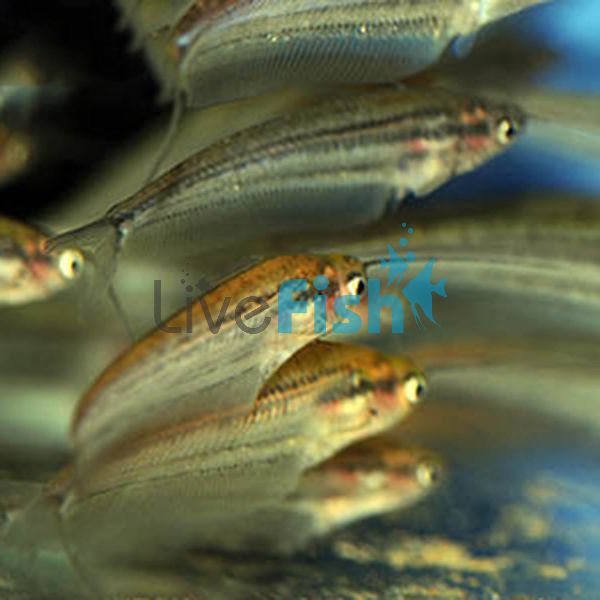Striped Glass Catfish 5cm
It can be hard to believe that a peaceful, schooling, midwater, and active catfish species exist but for the aquarists chasing a new and unique species to add life into their aquarium, then the striped glass catfish would be an amazing consideration. These fish are very closely related to the totally see-through phantom glass catfish and the only real difference is aesthetics. Once settled in, these community fish will be a great addition to any planted or peaceful system and will be a really interesting oddball species.
- Buy 5 for $5.63 each and save 10%
- Buy 10 for $5.01 each and save 20%
Striped Glass Catfish
It can be hard to believe that a peaceful, schooling, midwater, and active catfish species exist but for the aquarists chasing a new and unique species to add life into their aquarium, then the striped glass catfish would be an amazing consideration. These fish are very closely related to the totally see-through phantom glass catfish and the only real difference is aesthetics. Once settled in, these community fish will be a great addition to any planted or peaceful system and will be a really interesting oddball species.
Striped glass catfish have a really thin but long body that is almost knifelike in shape. These are a species that totally lack a dorsal fin, they can reach a length of 12 cm but all of their fins are on the bottom half of the body. The organs of this fish are basically compressed into the first 3 - 4 cm of their length and the rest just carries the earthy colouration of this fish. Whilst they are almost transparent, they do have a light brown skin which can also carry shades of light and olive green, Striped glass catfish get their name from the characteristic pair of dark blue stripes that run from head to tail. Their ventral fin constantly flutters in the water much like a ghost knife fish and all in all, these make for a great conversation starter species.
Breeding these fish in captivity has not really been seen in captivity all the much. Along with this, it is very uncommon for glass catfish to show signs of breeding at all. These are most likely species that scatter eggs or lay them in vegetation to then show no parental care afterward. Striped Glass catfish are naturally found in the calm waters of Thailand and Malaysia.
Tank Recommendations for your Striped Glass Catfish
The striped glass catfish can reach lengths of 10 - 12 cm and whilst these fish are active, it is better that they are kept in calm aquariums because of how these fish live in the wild. They come from slow-moving, vegetation-dense waters with a lot of botanicals in the water. The minimum tank size for a school of glass catfish is 70 litres and it is recommended to keep a minimum of 3 fish.
Giving these fish a well-planted aquarium would be great as it provides cover and breaks up the flow in the aquarium. They will however also do well in blackwater aquariums as long as there is cover for them to hide if required. they are mostly mid to top water-dwelling fish so the choice of substrate and aquarium hardscape is not a major concern. The glass catfish is a tropical fish that are best kept at 24-26 degrees with a PH of 5.0 - 7.0
Suitable Tank Buddies
The striped glass catfish really does need a proper selection of tank mates as they can very easily be stressed out or be outcompeted by fast fish. They are however incredible peaceful, non-predatory fish.
Usually Compatible
Bristlenose plecos, Borneo loaches, Khuli loaches, celestial pearl danios, emerald eye rasboras, and similar slow and species.
Sometimes Compatible
Angelfish, black widow tetras, Apistogramma, giant danios, and other fast-moving species could outcompete the striped glass catfish
Rarely Compatible
Tiger barbs, convict cichlids, red-tail sharks, and any fin-nipping or aggressive species could easily stress the striped glass catfish out.
Feeding your Striped Glass Catfish
Striped glass catfish should take a wide range of pellets, flakes, and frozen foods. Giving them a varied diet ensures that they have optimal nutrition. The ideal diet would be good quality slow-sinking food, supplemented with frozen bloodworms or black worms or even live foods like baby brine shrimp or micro worms.
| Scientific Name | Kryptopterus Macrocephalus |
|---|---|
| Care Level | Hard |
| Common Names | Striped Glass Catfish, False Glass Catfish, Poor Mans Glass Catfish |
| Diet | Omnivore |
| Fish Family | Siluridae |
| Lifespan (years) | 8 |
| Max. Length (cm) | 12 |
| Min. Tank Volume (l) | 70 Liters |
| Origin | Thailand & Malaysia |
| Reef Safe | Yes |
| Sociability | Peaceful |
| Venomous | No |
| Water Conditions | 24-26° C, pH 6.0-7.0 |




